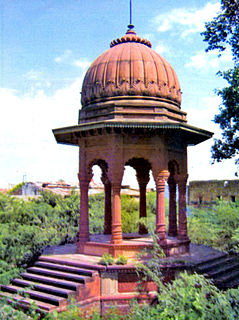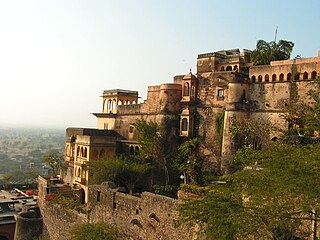
Shekhawati is a semi-arid historical region located in the northeast part of Rajasthan, India. The region was ruled by Shekhawat Rajputs. Shekhawati is located in North Rajasthan, comprising the districts of Jhunjhunu, parts of Sikar that lies to the west of the Aravalis and Churu. It is bounded on the northwest by the Jangladesh region, on the northeast by Haryana, on the east by Mewat, on the southeast by Dhundhar, on the south by Ajmer, and on the southwest by the Marwar region. Its area is 13784 square kilometers.

Chhatri are elevated, dome-shaped pavilions used as an element in Indo-Islamic architecture and Indian architecture. Originating as a canopy above tombs, they serve as decorative elements. The earliest example of chhatri being used in the Indian Subcontinent were found in the Shrine of Ibrahim in Bhadreswar, constructed between 1159 and 1175 AD.

Rao Raja Sri Sawai Pratap Singh Naruka was the founder king of Alwar State. He belonged to the Naruka clan of Kachhwaha dynasty.

The Kachhwaha or Kachawa is a Rajput clan found primarily in India. Sometimes families within the clan ruled a number of kingdoms and princely states, such as Jaipur, Bihar, Uttar Pradesh, Madhya Pradesh, Alwar and Maihar.
Loharu is a city, municipal committee and assembly constituency in the Bhiwani district of the Indian state of Haryana. It is the administrative headquarters of one of the four administrative sub-divisions of the district and covers 119 villages. It is also a railway junction station.

Major General Maharaja Sawai Man Singh II GCSI GCIE was an Indian prince, government official, diplomat and sportsman.

The region of Bikaner, stretching across northern Rajasthan State in India, was earlier known as Jangladesh. It included the present-day districts of Bikaner, Churu, Ganganagar, and Hanumangarh. It is bounded on the south by Marwar and Jaisalmer regions, on the east by Ajmer-Merwara region.

Samode Palace, Samode Haveli and Samode Bagh (Garden) are heritage monuments and structures built by the noble feudatory with the hereditary title of 'Maha Rawal' or 'Maha Saheb’ of the Amber and Jaipur principality in Rajasthan, India. All three have rich history of several hundred years and display a fusion of Mughal and Rajasthani art and architecture. They are now part of the Heritage group of hotels under the flagship name of "Samode" that are run by the hereditary owners of these structures. The Samode Palace is located 40 kilometres (25 mi) north of Jaipur city, the Samode Haveli is close to Jaipur and the Samode Bagh or Garden, 4 kilometres (2.5 mi) from the palace which is also run as a luxury hotel.

The Rambagh Palace in Jaipur, Rajasthan is the former residence of the Maharaja of Jaipur located 5 miles (8.0 km) outside the walls of the city of Jaipur on Bhawani Singh road.

The City Palace, Jaipur was established at the same time as the city of Jaipur, by Maharaja Sawai Jai Singh II, who moved his court to Jaipur from Amber, in 1727. Jaipur is the present-day capital of the state of Rajasthan, and until 1949 the City Palace was the ceremonial and administrative seat of the Maharaja of Jaipur. The Palace was also the location of religious and cultural events, as well as a patron of arts, commerce, and industry. It now houses the Maharaja Sawai Man Singh II Museum, and continues to be the home of the Jaipur royal family. The royal family has around 500 personal servants. The palace complex has several buildings, various courtyards, galleries, restaurants, and offices of the Museum Trust.The MSMS II Museum Trust is headed by chairperson Rajamata Padmini Devi of Jaipur. Princess Diya Kumari runs the Museum Trust, as its secretary and trustee. She also manages The Palace School and Maharaja Sawai Bhawani Singh School in Jaipur. She founded and runs the Princess Diya Kumari Foundation to empower underprivileged and underemployed women of Rajasthan. She is also an entrepreneur. In 2013, she was elected as Member of the Legislative Assembly of Rajasthan from the constituency of Sawai Madhopur.

Naruka is a clan of Rajputs found in India. Naruka Rajputs are offshoots of Maharao Naru Singh of Mozamabad, whose grandfather, Rao Bar Singh, gave up the throne of Amer kingdom. Rao Bar Singh was the eldest son of Raja Udaikarna of Amer. Naruka is the most prominent clan among Kachhwaha and holds an exceptional position in the history of India. They independently ruled on Alwar State.
Panchpana is the combined territories and thikanas ruled by the successors of Maharao Shardul Singh of Jhunjhunu, who belonged to the Bhojraj Ji Ka clan of shekhawats. The Bhojraj Ji Ka Shekhawats ruled over two territories; Pentalisa and Panchpana. The Bhojraj Ji Ka clan of Shekhawats were the most prominent among the shekhawat rajputs. They built many magnificent forts in their thikanas. Panchpana thakurs ruled over highest number of thikanas in Shekhawati. Many thikanas had their own flags and emblems.

Alwar State was a kingdom from 1770 to 1818 and a princely state under British rule from 1818 to 1947. Initially its capital was Macheri and then the city of Alwar. The nobility of Alwar State belonged to the Naruka branch of the Kachwaha dynasty. The kingdom was established by Naruka chief Rao Raja Pratap Singh in 1770 CE. Alwar State was one of the 19 princely states of former-Rajputana, which existed at the time of Indian Independence. The last reigning ruler, Maharaja Sir Tej Singh Prabhakar Bahadur, signed the accession to the Indian Union on 7 April 1949.
Baloda is a village in the Indian state of Rajasthan. Its mandal is Surajgarh and district is Jhunjhunu. It is located 17.7 kilometres (11.0 mi) from Surajgarh, 54.2 kilometres (33.7 mi) from Jhunjhunu, and 157 kilometres (98 mi) from Jaipur.
Diggi Palace is an Indian royal palace located in Jaipur, Rajasthan. It was converted into a heritage hotel, but a part is still occupied by the royal family, which also runs the hotel. The annual Jaipur Literature Festival has been held here since 2006.

Maharaja Abhai Singh Rathore was the Raja of Marwar (Jodhpur) Kingdom 24 June 1724 – 18 June 1749.

Madhogarh Fort is a fort located on top of Madhogarh Hill in the Aravalli mountain range, near Madhogarh village, in the Mahendragarh district of Haryana state in India. It is located 12 kilometres (7.5 mi) from Mahendragarh, reachable via Satnali Chowk or via Mahendragarh- Satnali- Loharu road.
Madhogarh is a village in Mahendragarh district, Haryana, India. It is located at the foot of Madhogarh Hill of Aravalli Mountain Range. Madhogarh Fort is on top of the hill.
The Raj Palace in Jaipur Rajasthan, India is more than two and a half centuries old palace converted into a grand heritage hotel.
The Battle of Kakkor was fought between the Maratha empire led by the veteran Gandadhar Tantiya ordered by Malhar Rao Holkar and the Rajput Kingdom of Jaipur under Sawai Madho Singh in present day Kakor, Uniara which resulted in a decisive Rajput victory













